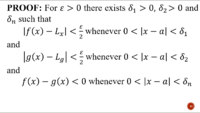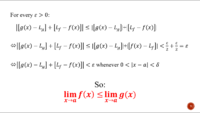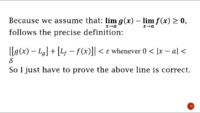Limit law by using the precise definition of limits:
- Thread starter khánh huy
- Start date
Dr.Peterson
Elite Member
- Joined
- Nov 12, 2017
- Messages
- 16,814
You might try proving this by contradiction. Suppose that f(x)≤g(x) for all x in some punctured open interval (b, a)U(a, c), and their limits are L and M respectively, with L > M. Show that a contradiction will result, so that it must be true that L≤M.
Please show us your work, even if it seems like almost nothing to you, so we can see if you are using correct ideas. You might start by stating the definition of a limit.
Please show us your work, even if it seems like almost nothing to you, so we can see if you are using correct ideas. You might start by stating the definition of a limit.
I don't prove by contradiction but I prove this way. Can you check for me if it is right or not? I'm not sure about the third condition in pic 1.You might try proving this by contradiction. Suppose that f(x)≤g(x) for all x in some punctured open interval (b, a)U(a, c), and their limits are L and M respectively, with L > M. Show that a contradiction will result, so that it must be true that L≤M.
Please show us your work, even if it seems like almost nothing to you, so we can see if you are using correct ideas. You might start by stating the definition of a limit.
Btw, thank you very much!!!!


Maybe I am missing something, but I do not see it. Your last line shows that the absolute value of the sum of two differnces can be made arbitrarily small. Looks fine to there. Then you conclude that one limit is not larger than the other. Why does the size of the absolute value of a sum tell us something about the sign of that sum?
I am not saying that you are wrong. I am saying that if you are right, the steps needed to prove that are not provided.
I am not saying that you are wrong. I am saying that if you are right, the steps needed to prove that are not provided.
pka
Elite Member
- Joined
- Jan 29, 2005
- Messages
- 11,988
Jeff, I agree. The last line in the proposed proof (with some rearrangement) is a standard in proving the limit of a sum is the sum of the limits.Maybe I am missing something, but I do not see it. Your last line shows that the absolute value of the sum of two differnces can be made arbitrarily small. Looks fine to there. Then you conclude that one limit is not larger than the other. Why does the size of the absolute value of a sum tell us something about the sign of that sum. I am not saying that you are wrong. I am saying that if you are right, the steps to show that you are right are not provided.
But in no way does it prove the inequality. I also agree with Prof. Peterson that this requires contradiction.
Maybe I am missing something, but I do not see it. Your last line shows that the absolute value of the sum of two differnces can be made arbitrarily small. Looks fine to there. Then you conclude that one limit is not larger than the other. Why does the size of the absolute value of a sum tell us something about the sign of that sum?
I am not saying that you are wrong. I am saying that if you are right, the steps needed to prove that are not provided.

Well, thank you. I think i should try contradiction. And can you check it for me when i finish. Thank you very much!!!Jeff, I agree. The last line in the proposed proof (with some rearrangement) is a standard in proving the limit of a sum is the sum of the limits.
But in no way does it prove the inequality. I also agree with Prof. Peterson that this requires contradiction.
I am sorry. I did not express my point clearly enough.
At all times we are assuming [MATH]0 < |x - a| < \delta.[/MATH]
[MATH]|[g(x) - L_g[] + [L_f - f(x)]| < \epsilon \implies[/MATH]
[MATH]|[g(x) - f(x)] - [L_g - L_f]\ [] + [L_f - f(x)]| < \epsilon \implies[/MATH]
[MATH][g(x) - f(x)] - [L_g - L_f] < \epsilon \text { OR } [L_g - L_f] - [g(x) - f(x)] < \epsilon.[/MATH]
[MATH]\text {Set } \gamma = g(x) - f(x).[/MATH]
[MATH]0 \le \gamma \ \because f(x) \le g(x) \text { by hypothesis.}[/MATH]
[MATH][g(x) - f(x)] - [L_g - L_f] < \epsilon \implies 0 < \gamma + \epsilon < L_g - L_f \implies L_f < L_g.[/MATH]
That is indeed what we want, but why do know that [MATH][g(x) - f(x)] - [L_g - L_f] < \epsilon.[/MATH]
There is another possibility. What happens then.
[MATH][L_g - L_f] - [g(x) - f(x)] < \epsilon \implies L_g - L_f < \epsilon \le \gamma + \epsilon.[/MATH]
We have NOT determined the sign of [MATH][L_g - L_f] - [g(x) - f(x)] ].[/MATH]
There is nothing so far to prevent it from being negative, which would DISPROVE the theorem to be proved. If you want to prove that the theorem is necessarily true, you need additional argument. When Dr. P and pka both suggest a proof by contradiction, I am betting that is the easiest way, perhaps the only way, to go.
Again, I apologize for being too obscure. What I saw was that you needed to prove something about a sign, not a size. So I could not follow what you were doing.
pka
Elite Member
- Joined
- Jan 29, 2005
- Messages
- 11,988
I will give an informal proof. It can be made rigorous(formal).Again, I apologize for being too obscure. What I saw was that you needed to prove something about a sign, not a size. So I could not follow what you were doing.
Notation, If ε>0 then Bε(F)=(F−ε,F+ε) or a ε-neighborhood of the number F
This is a change: let x→alimf(x)=F&x→alimg(x)=G and suppose G<F
That means F−G>0 so let ε=4F−G.
Thus Bε(G)∩Bε(F)=∅ [Draw a number-line, G is less than F.
So every number in the G-neighborhood is less than any number in the F-neighborhood.
You can pick δ so any x∈Bδ(x) then f(x)∈Bε(F)
But we know that f(x)≤g(x)∈Bε(G).
Do you see the contradiction?
Well, can you explain for me from the 5th line that why do we haveI will give an informal proof. It can be made rigorous(formal).
Notation, If ε>0 then Bε(F)=(F−ε,F+ε) or a ε-neighborhood of the number F
This is a change: let x→alimf(x)=F&x→alimg(x)=G and suppose G<F
That means F−G>0 so let ε=4F−G.
Thus Bε(G)∩Bε(F)=∅ [Draw a number-line, G is less than F.
So every number in the G-neighborhood is less than any number in the F-neighborhood.
You can pick δ so any x∈Bδ(x) then f(x)∈Bε(F)
But we know that f(x)≤g(x)∈Bε(G).
Do you see the contradiction?
Bε(G)∩Bε(F)=∅Bε(G)∩Bε(F)=∅.
pka
Elite Member
- Joined
- Jan 29, 2005
- Messages
- 11,988
O.K. because G<F and ε=4F−G you must look at these to open intervals:(G−ε,G+ε).Well, can you explain for me from the 5th line that why do we have
Bε(G)∩Bε(F)=∅Bε(G)∩Bε(F)=∅.
The diameter of that open interval is 2ε
Therefore (G−ε,G+ε) and (F−ε,F+ε) can have nothing in common.
DRAW a number-line diagram. Plot G to the left of F. Look at open intervals about G & F with radii 4F−G.
This may seem a very harsh statement, but if you are not able to establish that for yourself then maybe this question is not for you.
I have this question in my next seminarO.K. because G<F and ε=4F−G you must look at these to open intervals:(G−ε,G+ε).
The diameter of that open interval is 2ε
Therefore (G−ε,G+ε) and (F−ε,F+ε) can have nothing in common.
DRAW a number-line diagram. Plot G to the left of F. Look at open intervals about G & F with radii 4F−G.
This may seem a very harsh statement, but if you are not able to establish that for yourself then maybe this question is not for you.
pka
Elite Member
- Joined
- Jan 29, 2005
- Messages
- 11,988
Lets say that t∈(G−ε,G+ε)∩(F−ε,F+ε).I have this question in my next seminar
Given that ε=4F−G can you show that is impossible.
pka
Elite Member
- Joined
- Jan 29, 2005
- Messages
- 11,988
Let's say x→alimf(x)=F means that if ε>0 the ∃δ>0 such that if ∣x−a∣<δ then ∣f(x)−F∣<ε.ohh, can you explain for me why we have that:View attachment 12088
What the Hel*?? And I was a undergraduate major in philosophical logic with three course in symbolic logic to my credit.
A friend explained to me that all of that simply means that for any ε>0 we can find a δ>0 so that if x∈(a−δ,a+δ) then f(x)∈(F−ε,F+ε)
Well ok. That cleaned away some of the mud but not all. We (wife & I) stayed on after I finished the PhD thesis for her to do her MFA. In that time I worked in model theory & especially nonstandard analysis. During those two years the scales came off my eyes.
x→alimf(x)=F means that if x≈a then f(x)≈F.
Simply: if x is close to a then f(x) is close to F
